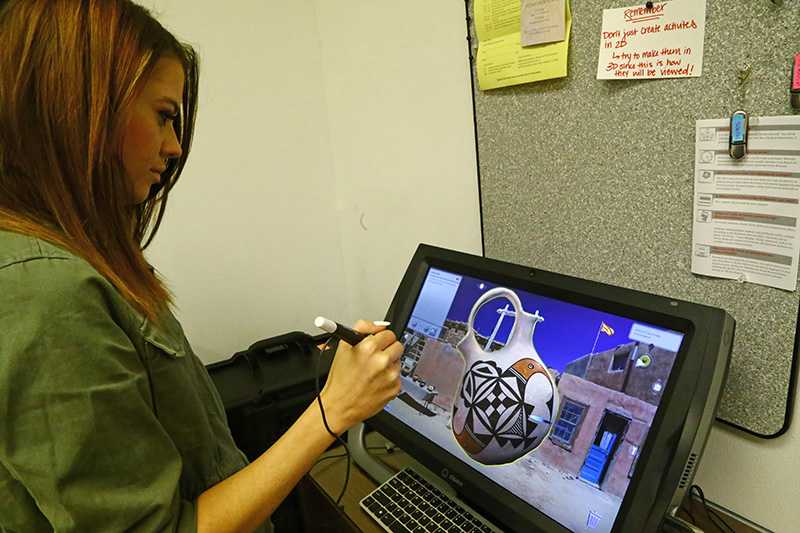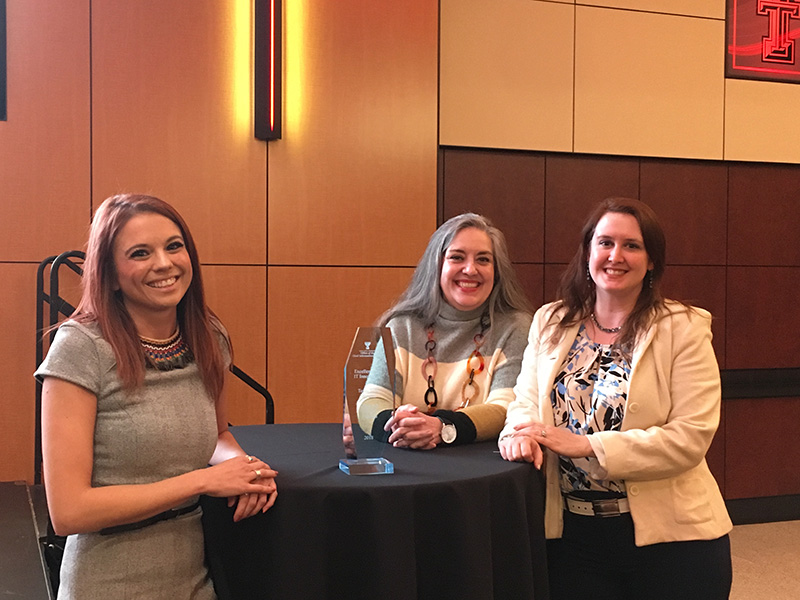Museum Project Wins Excellence in IT Innovation Award
The zSpace project at the Museum of Texas Tech University won the Excellence in IT Innovation Award from the university's Information Technology division. The award is presented to projects that demonstrate exemplary use of innovative technology.
 Danielle Marshall, a student in the Museum's Heritage and Museum Science master's
degree program, and Jill Hoffman, the Helen DeVitt Jones Curator of Education, received
the award in December 2018. Rebecca Hite, an assistant professor in the Texas Tech
College of Education, introduced the zSpace equipment to the Museum. She has worked
with Marshall and Hoffman to use the equipment.
Danielle Marshall, a student in the Museum's Heritage and Museum Science master's
degree program, and Jill Hoffman, the Helen DeVitt Jones Curator of Education, received
the award in December 2018. Rebecca Hite, an assistant professor in the Texas Tech
College of Education, introduced the zSpace equipment to the Museum. She has worked
with Marshall and Hoffman to use the equipment.
zSpace is a mixed reality technology device Marshall is using to create 3D models of objects from the William C. and Evelyn M. Davies Gallery of Southwest Indian Art Gallery, "Beyond Expressions in Clay." The goal of this project is to give the public a better understanding of collection objects through the use of interactive, 3D activities.
The incorporation of zSpace with the Davies collection creates a new type of visitor experience by allowing people to form a more personal connection to the objects. It also is a new form of digital documentation of the collection, which can later be used remotely for scholarly research.
 The technology works by incorporating elements of both augmented and virtual reality,
using a modified desktop computer, to provide an interactive experience that promotes
user-driven active learning. The system uses 3D glasses that have a series of embedded
sensors that provide a perception of depth, making the object on the screen appear
to come to life and float out of the screen. The zSpace system is extremely user-friendly,
which allows users of all ages to have an interactive and memorable experience, without
being intimidated by the technology. Using a stylus pen, the user can interact with
an object and manipulate it to get a 360-degree view. An additional zoom in/out capability
allows for examination of the objects as they hover in front of a user. For example,
a visitor can pick up a pot or storyteller doll and turn it any direction, look inside
it, or study a close-up view of the design, things that cannot happen with the real
object.
The technology works by incorporating elements of both augmented and virtual reality,
using a modified desktop computer, to provide an interactive experience that promotes
user-driven active learning. The system uses 3D glasses that have a series of embedded
sensors that provide a perception of depth, making the object on the screen appear
to come to life and float out of the screen. The zSpace system is extremely user-friendly,
which allows users of all ages to have an interactive and memorable experience, without
being intimidated by the technology. Using a stylus pen, the user can interact with
an object and manipulate it to get a 360-degree view. An additional zoom in/out capability
allows for examination of the objects as they hover in front of a user. For example,
a visitor can pick up a pot or storyteller doll and turn it any direction, look inside
it, or study a close-up view of the design, things that cannot happen with the real
object.
For a more in-depth look at the zSpace project, see the 2018 Fall-Winter edition of M Magazine.
Museum at Texas Tech University
-
Address
3301 4th Street, Lubbock, TX 79415 -
Phone
806.742.2490 -
Email
museum.texastech@ttu.edu
